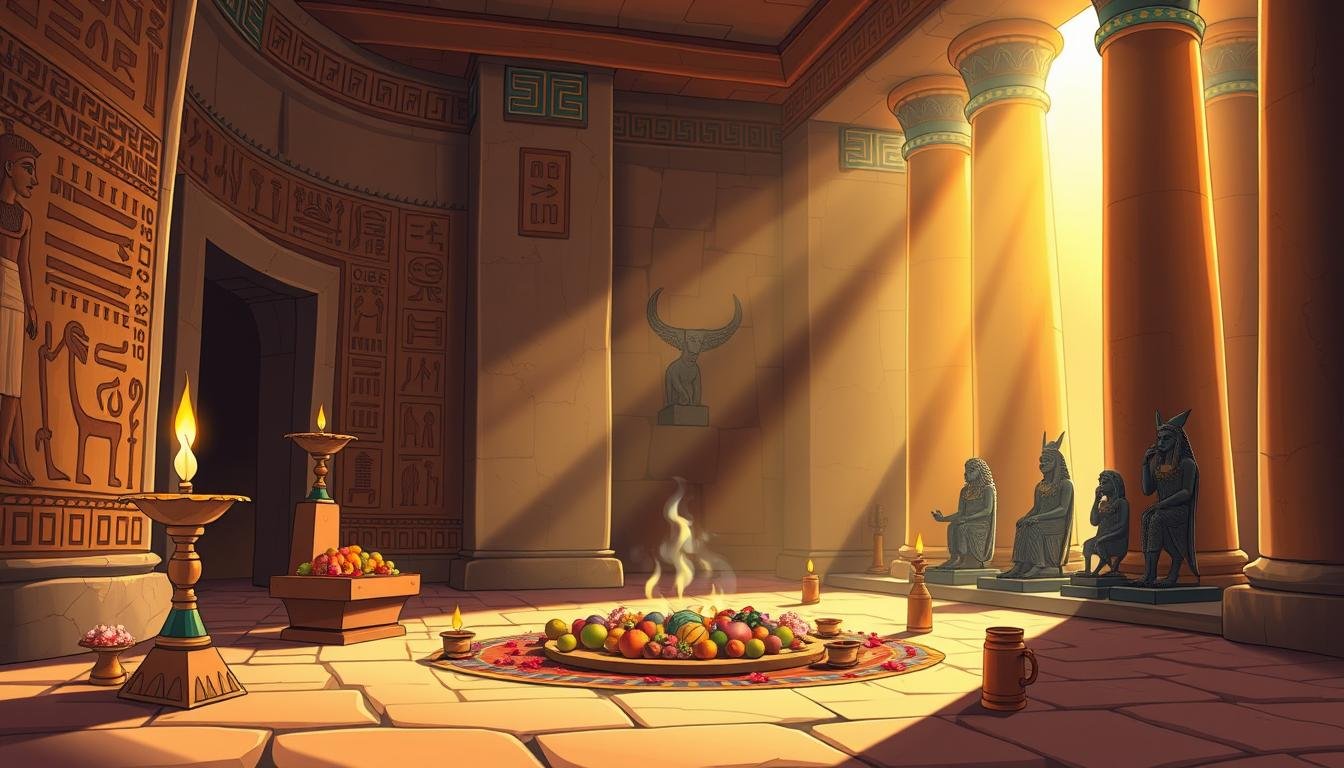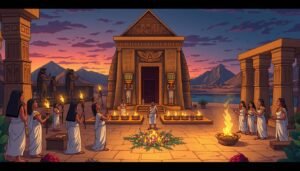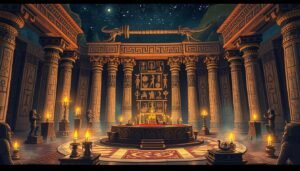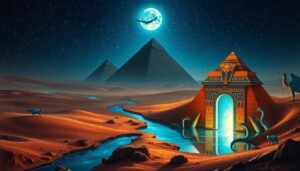In the shadows of the majestic pyramids and the echoes of the ancient Nile, the mystical rituals of the ancient Egyptians whisper tales of a time when magic reigned supreme. The first traces of this enigmatic art, known as Heka, date back to around 4500 BC1. From the grand temples where priests invoked the gods to the humble abodes where ordinary people sought solace in supernatural rituals, Heka permeated every aspect of ancient Egyptian life1.
The ancient Egyptians believed that Heka was a primordial force, one of the powers wielded by the creator deity to bring the world into existence1. This belief made their mystical spells and rituals very important. They wanted to be in line with the divine order. Heka was not just for the elite; it was a big part of daily life for everyone1.
The legacy of Heka is still seen today in many artifacts. These include intricate amulets cherished until the 5th century AD and spells on temple walls and papyri. Even today, Heka’s magic still fascinates us1. The 20th century saw a big interest in Heka again, thanks to Wicca1.
Key Takeaways
- Heka, the ancient Egyptian magic, dates back to around 4500 BC and was practiced by both priests and common people.
- Ancient Egyptians believed Heka was a primordial force used by the creator deity to bring the world into existence.
- Heka rituals and spells were an integral part of daily life in ancient Egypt, permeating all aspects of society.
- Artifacts such as amulets, temple inscriptions, and papyri provide a glimpse into the enduring legacy of ancient Egyptian magic.
- The 20th century saw a renewed interest in Heka with the rise of Wicca, reigniting the fascination with this ancient art.
Understanding Heka: The Primordial Force of Creation
In ancient Egypt, heka was very important. It was the power that made everything come to life. People knew about heka from the very start of Egyptian history2.
The Concept of Heka in Ancient Egyptian Religion
Heka was magic to the Egyptians. It was in words, actions, and rituals3. They saw it as a divine force, like a god named Heka, who helped create and keep life going2.
Every part of Egyptian life had magic in it. This included medicine and rituals2.
The god Heka was a man with a special beard and a staff with snakes2. He was magic itself. The symbol of Heka became the caduceus, known today in medicine2.
Heka as a Personification of Re-Atum’s Attributes
Heka was like a part of the creator god Re-Atum. It was not just magic, but also a way to connect with the divine. The Egyptians thought heka was the power that started the world.
“Magic is effective together with medicine. Medicine is effective together with magic.” – The Ebers Papyrus (c. 1550 BCE)2
The Ebers Papyrus shows how magic and medicine worked together. Doctors, or Priests of Heka, used magic to heal. They called on gods like Heka to help2.
Spells and incantations were used to fight diseases. The Egyptians thought these treatments could fight off evil spirits2.
But magic was not just for doctors. People used it every day for protection or to ask for god’s help2. This belief in heka’s power was a big part of Egyptian life.
The Role of Heka in Ancient Egyptian Cosmology
In ancient Egypt, heka was a big deal. It was the magic that helped create the world. People thought it was used in rituals to keep things in order4.
But heka wasn’t just for gods. It was for everyone. This made magic a big part of everyday life for all Egyptians4.
Heka’s Presence in the Solar Boat
Heka went with the sun god Re on his sky journey. This journey was key to keeping the world running smoothly. It showed how important heka was in keeping things balanced4.
Heka as a Force Accessible to Common Men
What made heka special was that anyone could use it. Unlike other places, magic wasn’t just for priests or kings. This made magic a part of daily life, with many using spells and amulets5.
“Heka was not just a divine force; it was a tool that could be harnessed by anyone who dared to unlock its secrets. In the hands of a skilled practitioner, heka could shape destinies, heal the sick, and even bend the will of the gods themselves.”
Heka’s Function in Preserving the Natural World Order
Heka’s main job was to keep the world in order. The Egyptians needed the Nile to live, so keeping things balanced was crucial. Heka was the magic that kept chaos away4.
They thought rituals and magic words could tap into heka. This kept the world running smoothly for over 3,500 years6.
Exploring ancient Egyptian heka shows it was more than magic. It was the glue that held the universe together. Learning about heka helps us understand ancient Egypt better.
Heka Rituals: Communicating with the Gods
In ancient Egypt, Heka was a powerful force. It connected mortals to the spiritual world. The ancient Egyptians thought Heka helped create the universe and keep it in order7.
They believed priests and priestesses could talk to gods with Heka’s help. This way, they could get the gods’ favor and advice7.

Heka as a Means to Interact with the Spiritual World
Heka was not just for the elite. It was in every part of ancient Egyptian life. People used Heka to protect themselves, heal, attract success, and keep evil away7.
They used magic to get richer, find good luck, and be prosperous in both worlds7.
The ancient Egyptians saw magic as a natural force. They thought it could make things happen. They believed using Heka let them talk to gods like Thoth, Isis, or Sekhmet for help8.
Monumental Temple Rituals and Everyday Magical Practices
In big temples, priests and priestesses learned powerful spells. They did this for years to change the world7. These places were where they held big ceremonies to please the gods7.
But Heka’s power wasn’t just in temples. Women played a big role in temple life, especially with Hathor9. They were “chantresses” of deities, showing their importance9.
“Heka was the power that created and sustained all life, including gods and humans. It was the force that the creator used to bring the world into existence and to maintain it.”
In daily life, people did magic like cleansing rituals and making offerings. They wrote down their wishes on papyrus and imagined it happening8. This way, they could connect with the divine and get help every day.
| Ritual Type | Purpose | Participants |
|---|---|---|
| Temple Rituals | Communicating with gods, seeking favor and guidance | Priests, priestesses |
| Everyday Magic | Protection, healing, attracting success, warding off evil | Common people |
Heka helped ancient Egyptians connect with the divine. Whether in big temples or daily magic, Heka rituals let people talk to gods. They sought their help, protection, and blessings in life.
The Origins and Evolution of Heka Magic
In ancient Egypt, magic and medicine were seen as one. This idea was called Heka. It was a powerful force that touched everything10.
The word “Heka” comes from the Egyptian language. It meant magic itself, a power beyond our world10.
The Coffin Text, spell 261, tells us Heka was there at the start. It says Heka was there before anything else existed10.
Early Evidence of Heka from 4500 BC
The first signs of Heka magic were around 4500 BC. Back then, the Egyptians started using magic in their lives. Magical amulets and writings from that time show us their beliefs and rituals.
Over time, Heka became a god. People worshipped him for his power10. The Old Kingdom Pyramid Texts show Heka as a special energy of the gods10.
Magical Amulets and Their Longevity in Ancient Egyptian Culture
Magical amulets were a big part of Heka magic. They were thought to protect, heal, and guide. These amulets were used for thousands of years, until about the 5th century AD. They even came back in modern times.
The long use of magical amulets shows how much the Egyptians believed in Heka. These objects were made with care and had powerful spells. They connected people to the gods.
| Type of Heka Magic | Purpose | Examples |
|---|---|---|
| Protective (“White”) Magic | Safeguarding against illnesses, dangers, and malevolent forces | Wadjet-eye amulets, invocations of protective deities like Shed and Tutu |
| Harmful (“Black”) Magic | Inflicting harm or exerting control over others | Curse tablets, magical figurines used in rituals |
The Egyptians knew two kinds of magic. “White” magic was good, and “black” magic was bad11. This shows they understood magic’s power and its risks.
As time went on, Heka magic was part of daily life in Egypt. Priests, magicians, and even pharaohs used it for healing and protection11. Everyone believed they could use Heka’s power, showing magic’s big role in their culture.
Heka in Tombs and Funerary Contexts
In ancient Egyptian tombs, heka magic was very important. It helped during the big change from life to death. Magical objects and spells were placed with the dead to help them on their journey.
Magical Objects Discovered in Ancient Egyptian Graves
Many magical objects were found in old graves. These included amulets and special wands. They were used to keep evil away and help the dead travel safely.
Inscriptions Referring to Magical Practices in Tombs
The walls of tombs tell stories of magic and rituals. These stories show how important heka was. The Opening of the Mouth ceremony was a big ritual with many steps.
This ceremony was not just for mummies but also for statues. It had many parts, each with its own magic and objects. Scenes of priests giving things to the dead are common, but there’s more to the story.
Written texts and pictures show the importance of this ritual. They help us understand ancient Egyptian beliefs. Heka magic was key in helping the dead reach the afterlife.
The God Heka: Personification of Magic
In ancient Egypt, Heka was a special god of magic. He was very old and loved by many. Heka helped create the world with his magic.

Heka was all about magic in ancient Egypt. People used spells and rituals to please the gods. Heka made these magic acts possible.
Heka was shown as a human, making him relatable to people. They saw him as a guide and protector. Priests of Heka also helped with healing, mixing magic and medicine.
“Heka was the energy which made creation possible and every act of magic was a continuation of the creative process.”
Heka was close to the creator god. He was seen as a spark of new life. This shows his power in creating and changing things.
The Egyptians saw healing as a mix of magic and medicine. Heka was at the heart of this. They used rituals, texts, and treatments to heal.
Heka was more than just a god. He was the soul of the sun god. This made him key in the universe’s balance.
Even after ancient times, people still studied Heka’s magic. In the late 1800s and early 1900s, his magic drew scholars and fans.
Heka was the king of magic in ancient Egypt. His magic touched the lives of many. He left a lasting mark on history.
Weret Hekau: The Cobra Goddess of Magic
Weret Hekau is a powerful goddess from ancient Egypt. She is known for magic and protecting the gods. Her name means “Great of Magic” and is linked to many goddesses and gods12.
Weret Hekau as a Foster-Mother to Divine Kings
Weret Hekau is more than a goddess of magic. She is also a foster-mother to the kings of Egypt12. This shows her role in protecting and helping the pharaohs. The Ebers Papyrus, from 1500 BCE, mentions Weret-Hekau, showing her importance13.
The Power of Weret Hekau in Royal Crowns
The royal crowns of Egypt were magical. They were said to have Weret Hekau’s magic in them14. The crowns had uraeus serpents, which added to their magic1214.
These serpents were believed to protect the king and give him magic power1214.
Weret Hekau could take many forms, like a woman with a cobra head or a full cobra1214. This shows how magic is everywhere in Egyptian culture. In Tutankhamun’s tomb, a figure of Weret-Hekau was found, showing her importance in funerals13.
As “Lady of the Palace,” Weret Hekau was very important in royal life1214. Priestesses prayed to Isis-Werethekau for health and life. They used snake-shaped wands to connect with her magic.
Weret Hekau’s story shows the power of magic in ancient Egypt. She helped kings, queens, and many others. Her legacy reminds us of the magic and wonder of ancient Egypt.
Types of Heka Rituals: Everyday, Temple, and Personal
In ancient Egypt, Heka was a magic force. It was used in many rituals. These rituals were for everyday life, temple use, and personal spells1.
Everyday rituals were common. People did them to face daily life. They were about asking for god’s help and protection1.
Temple magic was for priests. They healed and told fortunes. Priests used plants and magic words in temples15.
Personal spells were for personal goals. People used magic to change their lives. They used amulets and charms for this15.
| Type of Heka | Practitioners | Purpose |
|---|---|---|
| Everyday Rituals | Ordinary People | Invoke the power of the gods, ensure protection and favor |
| Temple Magic | Priestly Class | Honor the gods, maintain cosmic order, healing and divination |
| Personal Spells | Individuals | Influence personal destiny, ward off evil, attract love, bring prosperity |
The ancient Egyptians thought Heka was key to the world’s creation. They used it in their rituals. This helped them live in harmony with the gods and nature1.
Akhu: Another Facet of Ancient Egyptian Magic
In ancient Egypt, heka was key in rituals16. But there was also akhu, a magic used by stars and gods. It was not good or bad but a neutral force.
The Difference Between Heka and Akhu
Heka and akhu were both important in ancient magic. Heka was tied to many parts of life, like love and health1718. Only a few could use heka, born with it or gained later17.
Akhu, however, was for the stars and gods. It was a power beyond humans.
The Use of Akhu by Stars and Deities
The ancient Egyptians saw akhu as very powerful. It was used by the stars and gods in secret ways. Scholars today still try to understand its role in ancient Egypt’s beliefs.
FAQ
What is Heka in ancient Egyptian magic?
Heka is a magical power from the start of the world. It was used in rituals to keep things in order. It was linked to the god Re-Atum.
How did ancient Egyptians use Heka rituals to communicate with the gods?
They used Heka rituals to talk to the gods and ask for luck. These rituals were done in big temples and daily life.
What is the earliest evidence of Heka magic in ancient Egypt?
We first hear about Heka magic around 4500 BC. Magical items from then were still used until the 5th century AD. They are used again today.
What magical objects have been discovered in ancient Egyptian tombs?
Many magical items have been found in old Egyptian graves. They show how magic was used in funerals.
Who is the god Heka in ancient Egyptian religion?
Heka is an old Egyptian god shown as a human. He was linked to the sun god and creation.
What is the significance of the goddess Weret Hekau in ancient Egyptian magic?
Weret Hekau was a cobra goddess and a mother to the kings. She was in the royal crowns and in magicians’ wands.
What are the different types of Heka rituals in ancient Egypt?
There were three kinds of Heka rituals. They were for everyday life, temple use, and personal life. They all connected with each other.
How does Akhu differ from Heka in ancient Egyptian magic?
Akhu was magic used by stars and gods. It was not seen as good or bad. But Heka is more understood today.
Source Links
- https://www.ancient-origins.net/history-ancient-traditions/magic-heka-ancient-egyptian-rituals-have-crossed-cultures-and-time-006668 – The Magic of Heka: Ancient Egyptian Rituals That Have Crossed Cultures and Time
- https://www.worldhistory.org/Heka/ – Heka
- https://library.fiveable.me/gods-graves-and-pyramids-ancient-egyptian-religion-and-ritual/unit-7/concepts-heka-egyptian-magic/study-guide/0svDBXheo9zoJCgz – Concepts of Heka and Egyptian Magic | Ancient Egyptian Religion Class Notes | Fiveable
- http://www.sofiatopia.org/maat/heka.htm – ANCIENT EGYPT : To Become a Magician : I AM HEKA !
- https://library.fiveable.me/gods-graves-and-pyramids-ancient-egyptian-religion-and-ritual/unit-7 – Ancient Egyptian Magic and Rituals | Ancient Egyptian Religion Class Notes
- https://en.wikipedia.org/wiki/Ancient_Egyptian_religion – Ancient Egyptian religion
- https://assets.website-files.com/66f3ce8ff5b72adfc087d82e/67103aef9a44be8adac7b1cb_11463707106.pdf – Heka magic spells pdf
- https://www.kemeticblog.com/kemetic-spirituality-for-beginners-how-to-get-started-in-egyptian-neo-paganism-part-4-of-4/ – Kemetic Spirituality for Beginners
- https://www.britannica.com/topic/ancient-Egyptian-religion/The-cult – Ancient Egyptian religion – Gods, Rituals, Beliefs | Britannica
- https://en.wikipedia.org/wiki/Heka_(god) – Heka (god)
- https://www.thecollector.com/magic-ancient-world-egyptian-deities/ – Magic in the Ancient World: Egyptian Deities and Uses
- https://isiopolis.com/2015/07/26/werethekau-isis-great-of-magic/ – Werethekau & Isis Great of Magic
- https://iseumsanctuary.com/2022/01/07/gengen-wer-and-weret-hekau-creative-energy-and-magic/ – Gengen-Wer and Weret-Hekau – Creative Energy and Magic – Iseum Sanctuary
- https://isiopolis.com/2024/06/09/the-goddess-werethekau-isis/ – The Goddess Werethekau & Isis
- https://www.landofpyramids.org/heka.htm – Heka ***
- https://brill.com/display/book/edcoll/9789004390751/BP000018.xml – No title found
- https://www.hogwartsishere.com/courses/ANST-401/lesson/79/ – Ancient Studies (ANST-401) | Lesson 2 | HiH
- https://markberepeterson.com/category/paganism/kemetism/ – Kemetism – Mark Bere Peterson’s Hauntings, Urban Legends, Paganism & Witchcraft




